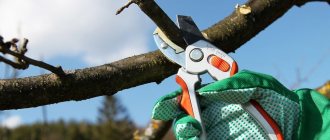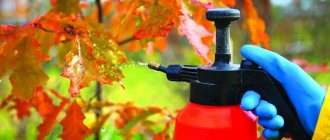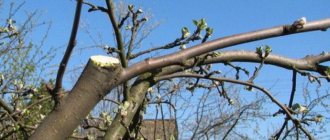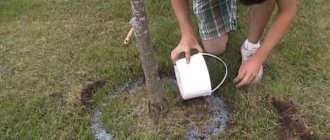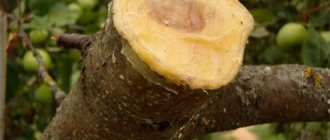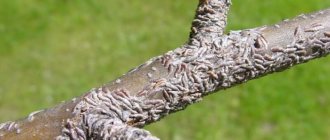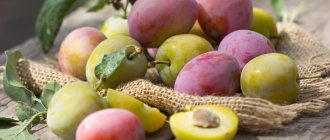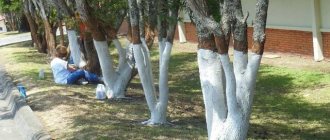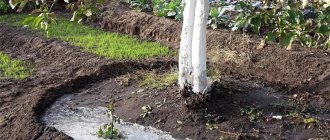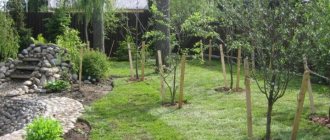Author: Natalya Category: Fruit and berry plants Published: October 15, 2015Republished: February 16, 2019Last edits: November 26, 2020
- When to prune
- Timing of pruning
- When to prune cherries
- When to prune an apricot
- When to prune
- When to prune
Trees in the garden require care all year round, and the longevity and productivity of fruit crops depend on how competently it is carried out. One of the most important points in caring for trees and shrubs is pruning, the main task of which is the correct formation of the crown. Formation begins at a young age, and its essence boils down to leaving and stimulating the necessary branches for development and fruiting, and removing those that interfere, those that grow incorrectly, old and diseased ones. Along with such care measures as fertilizing and protection from pests and diseases, proper pruning helps the plant to evenly distribute nutrition and strength, so the harvest on trees with a well-formed crown is abundant and the fruits are of high quality.
Timing for pruning trees in autumn
The autumn pruning procedure helps trees to withstand winter cold more easily, and also has a very positive effect on the quality characteristics of the future harvest. But it must be done on time.
Gardening activities begin when nutrients move from the leaves to the trunk and roots, that is, with the fall of the leaves. At this time, sap flow slows down, the tree is preparing to retire, and therefore is least susceptible to injury.
It is best to carry out operations to remove excess growth in September or October. Then the tree will have time to adapt to its new “look” even before the onset of frost and will survive the winter more easily.
In November, it is extremely undesirable to engage in them. After all, if frost hits, the bark in the cut areas will freeze, and the wood underneath will begin to shrink. As a rule, green space injured in this way ultimately dies.
Attention!
Autumn pruning of trees and shrubs is carried out exclusively in regions with a temperate climate. It is extremely undesirable to carry out such procedures in the northern regions: the plants do not have time to recover before the onset of frost.
Fruit tree pruning
Pruning is the complete or partial removal of shoots and branches, a method of caring for ornamental and fruit shrubs and trees, serving to regulate their development, growth and fruiting. In addition to the formative function, pruning also performs a sanitary function - it thins out the crown and frees the tree or bush from branches that endanger the health of the plant and jeopardize its longevity. And if the tree has reached an advanced age, then timely rejuvenating pruning will give it new strength and prolong the years, practically without reducing the quantitative and qualitative indicators of the harvest.
Tree pruning is done both in spring and autumn; in some cases, trees are pruned even in summer. Let's make a reservation right away: autumn pruning of trees is permissible only in areas with mild, non-cold winters, and in the northern regions it is better to carry out this procedure in the spring, since frosts that occur soon after autumn pruning lead to freezing of the bark at the cut sites and dry out the wood, which, as a rule, leads to plant death. There are types of fruit trees that are pruned every year, or even twice a year, and there are those that do not need annual pruning.
Each agricultural technique has its own rules, and tree pruning is no exception. When to prune trees of certain types and how to prune fruit trees in the fall are the topics of our conversation.
- Actinidia: growing in the garden, types and varieties
Pruning trees and shrubs in autumn, main principles
Attention!
Autumn pruning can only be done on winter-hardy varieties of fruit trees.
Basic principles of pruning
Most often, the gardener's autumn concerns come down to only sanitary pruning of trees. Everything else is postponed until the spring.
But sometimes it is advisable to perform other types of circumcision:
- shortening shoots on first-year plants;
- thinning the crown for better lighting and ventilation;
- its formation according to a predetermined contour;
- rejuvenation of trees.
The procedure is performed in the following order:
- First of all, they carry out sanitary pruning of branches that are diseased, withered, attacked by pests, and also broken due to bad weather or under the weight of the crop.
- Remove all tops and root shoots without exception.
- Next, they get rid of the weakest ones, those growing closely, directed towards the center or vertically upward, as well as branches rubbing against each other.
- In the case of anti-aging pruning, old and unpromising branches are removed.
- Wounds caused during the procedure are carefully treated. For this, garden varnish is most often used.
- All biomaterial obtained as a result of such processing is immediately removed to a considerable distance and must be burned.
Advice!
In the absence of garden varnish, you can use regular oil paint. Moreover, it is even preferable if the cuts are large or there is a high risk of rapid onset of cold weather.
The following figure will help you see in more detail which branches must be removed:
Features of pruning trees of various types and age groups
When pruning young trees, the removal of branches is insignificant. Its main purpose is to form a crown.
The following types are distinguished:
- longline with a central conductor (or leader);
- changed-leader;
- cup-shaped.
A tree that has already entered the fruiting stage needs more severe pruning. At the same time, some branches are cut out completely, while others are only shortened. Such measures allow you to increase the yield, as well as strengthen the structure of the crown so that the branches do not break under its weight.
Old trees need rejuvenating pruning. At the same time, more than half of the old, least productive and unable to provide proper nutrition branches are removed. After carrying out this procedure, the yield decreases slightly in the first year, but then the tree begins to bear fruit with renewed vigor.
Dwarf breeds also need pruning. But they grow much slower than usual. Therefore, you need to cut off much fewer branches from them.
As for shrubs, they wake up very early, so autumn pruning is much preferable to spring pruning for them. This procedure is not only a way to keep them in good condition. This is also an excellent opportunity for rejuvenation, as well as improving the quality characteristics of the crop.
Removing old branches stimulates the growth of young shoots. In addition, this creates conditions for better ventilation and penetration of sunlight. This means that the bush is less susceptible to attacks by various fungi, and the berries on it become sweeter.
Adviсe!
In most cases of fruit tree pruning, removing a few branches each year is much easier to handle than mass pruning of branches every few years.
As a rule, the number of branches cut should be approximately equal to last year's growth (but not more than a third of the crown).
First of all, old, unproductive branches are removed.
Cherry pruning
When to prune
It is better to form the crown of cherries in the spring, but autumn pruning of cherries is carried out not only for sanitary purposes, like other garden trees, but also in order to rejuvenate the tree - these are the recommendations of most experts. However, there are practitioners who believe that pruning cherries in the fall should be done only in emergency cases - in order to remove diseased or injured shoots. Heavy pruning of cherries in the fall slows down their fruiting.
It’s up to you to decide what to do correctly. You can try rejuvenating pruning in the fall, and if you don’t like the results, next time reschedule the pruning until the spring.
In the photo: Ripe cherries on a branch
Autumn pruning
Professionals recommend forming the crown of the cherry tree in the shape of a cone with a wide base - it warms up and is well lit, and air circulates freely between the branches. You can also form the crown in a cup-shape or in tiers. In the fall, after the leaves fall, remove all diseased, dry, broken and disease- or pest-damaged branches and shoots. In order to rejuvenate the crowns, branches six to eight years old are cut into rings, and the sections must be treated with garden varnish or oil paint.
- Mulberry: cultivation, care, planting and pruning
Proper planting and care of cherries in the garden
Pruning trees in autumn for beginners in pictures
When starting to trim trees, it is very important to navigate not only how to choose the right tools and time, but also what is the best technology to use to remove excess vegetation. But it is with the last point that novice gardeners most often have problems. The pictures presented here will help you better understand which elements of the tree should be cut first and what is the best way to do it.
branches subject to mandatory removal
Everyone knows that dry and diseased branches are cut out first. Then those that grow inside the crown or interfere with each other. Next, you need to look at the angle between the branch and the trunk.
The closer it is to zero (or 180 degrees, if the branches are directed downwards), the less these branches are predisposed to fruiting.
Therefore, experienced gardeners strive to leave (or form as such) the maximum possible number of branches growing perpendicular to the trunk. After all, it is on them that the largest part of the “fruits” are formed, which are the basis of the future harvest.
Advice!
If the frame branches grow incorrectly, it is not advisable to prune them. It is best to stretch such branches with a rope and secure them. After 2-3 weeks you can release them, or you can leave the tree in this state until spring.
Features of cutting branches
It is important not only to identify the branches needed to remove, but to cut them correctly. The following techniques are used:
Thin branches are cut using pruning shears; for thick ones, a saw is used. It is very important to leave as even cuts as possible on the tree, as well as to use the correct techniques for removing branches. Mistakes here are fraught with a decrease in yield, the development of diseases and even the death of the tree as a whole.
How to increase productivity
To increase fertility rates, it is necessary to leave horizontal branches when pruning. Gardeners' observations show that the greatest number of fruits are produced by branches growing parallel to the ground. Autumn pruning of trees helps to increase productivity, because by eliminating diseased and unnecessary branches, the tree receives more strength in order to direct them to the formation of fruits.
If the gardener notices that the frame branches are growing at the wrong angle, then cutting them is contraindicated. Otherwise, you will have to wait a year or two for the harvest. It is recommended in such situations to stretch the branches, setting the desired direction for growth according to the following pattern:
- Using a rope, bend the branches to the desired position or to the maximum allowable angle.
- Then the branch is fixed in this position for 12-15 days.
- After the specified period, if the branch did not initially take the required position, it is pulled again, trying to achieve a greater angle of inclination than the last time.
The procedure is repeated until the branches from which the crown is formed bend into the desired position. Having achieved this, the branches are fixed and left to overwinter. By the next harvest, they will already be growing correctly, which will increase the fertility rate. When forming the crown, it is important not to be overzealous, otherwise the branches may break, after which all that remains is to carefully cut them off.
If you need to quickly achieve results or the frame branches grow at the wrong angle, then sometimes more radical measures are used. After winter, branches that need shaping are specially broken, setting a new direction of growth, and the broken area is tightly wrapped with cling film.
By the onset of autumn, the wound inflicted on the tree will heal, and the frame branches will take the angle of inclination desired by the gardener. This is a dangerous technique that can cause irreparable damage to the tree. Therefore, only experienced gardeners can perform it.
How to properly prune an apple tree in the fall, diagram
The apple tree is one of the most popular trees in our latitudes. Not everyone knows this, but it can bear fruit for about a hundred years. But you cannot do without proper care, one of the elements of which is proper pruning.
The scheme for its implementation depends on the age of the apple tree and can be carried out in one of the following ways:
- strong – removal of about 2/3 of the annual growth;
- medium (moderate) – cutting out about half of the growth of the shoot;
- weak - shortening of the shoot by 1/4-1/3 of the annual growth.
Together with them, thinning is also used, that is, cutting out entire shoots.
When formative pruning of young seedlings, light pruning is used with cutting out some shoots entirely. In this case, the central conductor should rise 15-30 cm above the other branches. Skeletal branches are formed from 3-5 lateral shoots, shortened to a bud and leaving their ends at the same level. All competitors are cut into a ring.
During the period of active fruiting (5-10 years), the main task of pruning is to activate the “fruits” and, accordingly, increase the yield. In this case, strong thinning is combined with weak (or medium) shortening. In this way, the density of the crown is regulated, as well as the growth and desired direction of overgrowing branches.
The video will help you better understand all of the above:
Older apple trees need rejuvenation. In this case, severe pruning of apple trees is used: the skeletal branches are cut to the area where the tops appear, and the crown is partially thinned out. The procedure improves the conditions for fruit ripening, which has a better effect on their quality. The branches that need pruning during rejuvenation pruning of old apple trees are perfectly illustrated by the diagram:
Pear pruning
When to prune
Beginners in gardening believe that pruning a pear tree is no different from pruning an apple tree, but this is not entirely true. We will tell you about when and how to prune a pear, and you can do a comparative analysis yourself. Pear trees, like apple trees, are not recommended to be pruned every year.
Autumn sanitary pruning of pears is permissible as long as the temperature outside is above zero, but if frosts unexpectedly hit, then pruning must be postponed until spring - trees cannot be pruned in cold weather, since the wounds remaining after pruning not only do not heal, but also lead to freezing of the branches, which is why they die. It is best to prune a pear in the spring, when the air temperature warms up to 8 ºC.
However, if there is a need to do this in the fall, then pruning in September is quite acceptable, but not later. The most convenient crown shape for harvesting is pyramidal, and this must be taken into account when formative pruning of pears.
In the photo: Pears on a tree
Autumn pruning of pear
The formation of the crown of pear trees begins already in the first year of life: it is very important to determine the skeletal branches immediately, so that in the future the crown develops correctly and symmetrically. Annual seedlings are pruned at a height of 40-50 cm from the ground. In two-year-old trees that have already acquired 6-8 lateral branches, select 3-4 of them as skeletal branches and prune them at the same level. The conductor is cut 20 cm higher than the skeletal branches.
Pruning older trees in the fall primarily serves sanitary purposes: removing branches that thicken the crown, diseased branches, and those damaged during the fruiting period. It also doesn’t hurt to shorten the annual shoots by a third of the length, and even the crown if the pear is stretching upward too much - this will strengthen the tree, enhance its branching and serve as an impetus for enhanced bud development. However, when pruning, try not to disturb the pyramidal shape of the crown. After completing the procedure, treat cuts and damaged bark with garden varnish: on old, dry branches immediately, and on young, green branches only after a day.
Proper planting and care of pears in the garden
To prune to rejuvenate an old pear, you need to start by shortening its top, but if you have been conscientiously pruning the tree from year to year, and the height of the crown corresponds to optimal indicators, then proceed to thinning it: remove dry, old, non-fruiting branches, cut out shoots , growing at an acute angle or parallel to the trunk, and shorten the remaining shoots by a quarter of the length. Treat all sections with garden varnish or drying oil paint.
To be fair, it should be said that rejuvenating pruning of old pear branches is less painful for the plant in the spring, when the air temperature reaches 5 ºC, but the buds have not yet woken up.
- What to do in the garden in August
How to prune a pear tree in autumn
Like an apple tree, excess growth is also removed from a pear tree, which often naturally forms a well-shaped crown with a central conductor. Usually it is not as dense as that of an apple tree, so it needs similar, but less severe pruning. In addition, since the tree has a tendency to freeze in winter, it is pruned lightly.
But due to the fact that some of the active buds of the pear die, the sleeping ones awaken. And among them, a lot of tops always form, which the gardener must work on. By shortening such shoots are transformed into semi-skeletal and overgrowing branches. All others are removed so as not to interfere.
Attention!
According to experts, it is the autumn pruning of pears that brings the greatest benefit to the tree.
Only pears of early and medium varieties are processed in this way.
In the first year after planting, the seedling is not pruned.
Features of pruning an apple tree
What time to prune
Apple trees are pruned in spring and sometimes in summer, when ripening apples lack light due to the crown being too thick. It is also carried out in the autumn. In the spring, before sap flow begins, those branches that have frozen over the winter are removed, and at this time the crown is formed. In autumn, the apple tree is pruned in November and, as a rule, the crown is sanitized. In this case, pruning in the fall can begin only after the end of leaf fall. Columnar apple trees should be pruned either in the first days of summer or before winter.
Autumn pruning
In autumn, you need to remove those branches that are old, injured, diseased or have signs of rotting. Since the plant is at rest at this time, this procedure does absolutely no harm to it.
Approximate plan for autumn pruning of an apple tree:
- first you need to remove large branches that are injured or dry;
- of the branches growing very close to each other, the strongest should be left and the rest removed;
- cut off branches growing at an acute angle;
- the places of cuts must be covered with paint on drying oil or garden varnish, while dry branches are treated immediately, and young ones - after 24 hours;
- branches that have been cut must be destroyed.
If the apple tree is young, then only light pruning is done with pruning shears, and the growth of this year should be shortened by ¼ of the current year's growth. After this, these specimens are not pruned for 3–5 years, cutting off only dried and injured branches. However, this is only if the tree does not grow in height too quickly. Those apple trees that are 5-6 years old require medium-intensity pruning - strong branches are shortened by 1/3 of their length. Old apple trees are pruned for rejuvenation in 3 stages. So, in the first year you need to remove approximately 1/3 of all old branches, in the second year another 1/3 of the old branches, and the remaining 1/3 after another 1 year. It is worth considering that pruning shears cannot cope with mature powerful branches; you cannot do without a saw. We must also remember that the tools used to trim branches must be very sharp and should be disinfected.
How to prune a columnar apple tree
Regarding the care of columnar apple trees, we must remember that the more intense the pruning, the faster and better the remaining branches will grow. If you cut off more than ½ of the branch, then from those 3 or 4 buds that remain, strong shoots will grow next spring. If less than ½ of the branch is removed, then from those 5–7 buds that remain, 5–7 average shoots will grow. It is prohibited to cut the central conductor of the column, otherwise the crown will branch. If, when forming, they want to achieve a columnar crown, then after planting the seedling, its crown shoot must be tied to a support. Fruit links should be formed from the side shoots. Excessively powerful shoots must be cut into a ring, because they may stunt the growth of the conductor. After the young shoots grow, they form the skeleton of the crown.
Autumn pruning of trees. How to prune an apple tree in autumn
How to prune a plum tree in the fall
Regarding autumn pruning of plums, expert opinions differ. Supporters complain that due to the vagaries of the weather in the spring, you simply may not have time to complete this procedure. Opponents appeal to the fact that mistakes made at this time can become fatal for the tree.
Indeed, autumn cuttings do not last well. The reason for this is a suspension in the growth of cambial cells. Based on the above, it is best to carry out only sanitary pruning of plum trees in the fall. When preparing a tree for winter, it is imperative to remove dry, diseased and broken branches from it, and in some cases also thin out the crown so that it is not injured by a large amount of snow.
For trees in the active fruiting phase, the procedure is carried out according to the following scheme:
Should you prune a tree in spring or fall?
Spring pruning is preferable because the tree will soon wake up and the wounds will heal faster. That is why in the fall they try to carry out only sanitary pruning.
Some trees, for example pear, cherry, plum, may become sick after autumn pruning or even die. It is also poorly tolerated by young seedlings.
Removal of branches broken off by a storm, snow or icing is carried out immediately, without paying attention to the time of year. The only reason why the operation can be postponed is the temperature outside is below -50C.
In the southern regions, where there are almost no severe frosts, pruning can be done in winter. Thanks to this, in large industrial orchards it is possible to treat all the trees before the sap begins to flow.
How to prune currant bushes in autumn
All types of currants are pruned during the dormant period, when the bushes have neither leaves nor buds.
At the same time, no more than 10 large branches are left on young bushes. On those that have already begun to bear fruit, about a third of the oldest shoots are removed. This is done at the root, near the ground. By the way, in a similar way they get rid of unripe shoots, which, when frozen, significantly reduce the immunity of the plant as a whole. The remaining branches, for better branching, are shortened to the first bud.
Black currant branches bear fruit best at 3-5 years, and white and red ones at 2-5 years. Then they gradually lose productivity. Therefore, all aged branches must be removed. But at the same time, you definitely need to take care of new ones, leaving 3-5 mature replacement shoots every year.
Adviсe!
After removing the shoots from the currant bushes, they need hilling. After all, new branches must sprout from the roots.
Everything that concerns pruning red and white currants can also be applied to gooseberries.
Fall pruning goals
- Giving the crown the correct shape and decorative appearance.
- Increasing the thickness and strength of branches. Shoots that are regularly shortened become thicker. A strong tree with strong branches is less likely to break during harvest ripening.
- Garden rejuvenation. Regular tree care prolongs their youth and active fruiting.
- Subsequent ease of care. A properly formed crown is the key to easy tree care and easy access to any part of the crown.
- Health improvement. Healthy branches stimulated by pruning are not affected by fungal infection.
What's the best way to prune grapes in the fall?
Autumn pruning of grapes is one of the mandatory procedures for this crop. At first glance, the operation is quite complicated, but if it is neglected, the plant will devote all its energy to forming a vine, and then you will simply have to forget about the harvest. Therefore, every beginning winegrower simply needs to master it.
They begin to form a grape bush only after it has completely gotten rid of foliage, but before the onset of persistent cold weather. For good yield and early fruiting, immediately after planting, two main shoots are formed on the grapes.
In the second year of life, in order for the seedling to gain strength, it is shortened by two buds, and in the summer the excess is pinched off. In the third year, removing all unnecessary branches, the fruit link is finally formed: sleeve-knot of replacement-vine of fruiting.
Attention!
The length of pruning vines for each variety is different and depends on its characteristics: short - for 4 buds, medium - for 4-8 and long - for 8-12, and sometimes up to 20 buds (by the way, the first two can be ignored).
When performing the procedure, all cuts left on each of the sleeves must be on one side. Otherwise, circular tissue necrosis may occur, which will lead to the death of the plant.
The formation of a grape bush in the first two years of life is as follows:
In general, starting from the third year, the scheme for autumn pruning of grapes looks something like this:
- All fruit-bearing vines, tops, as well as weak and interfering shoots are cut off.
- All unnecessary branches are removed from young bushes, and annual branches from old ones.
- Fruiting vines are shortened depending on the individual characteristics of the variety. Replacement knots - 3-4 buds.
Adviсe!
Without knowing exactly what variety you are pruning, in order to accurately get into the fruiting zone, it is best to prune by 6-8 buds.
The weaker the shoot, the fewer buds are left on it.
Top shoots are cut out both completely and for replacement knots.
When pruning in autumn, it is advisable to leave 2-3 times more shoots than necessary. This is due to the possibility of them freezing. In the spring, everything unnecessary must be removed.
Step-by-step instruction
Experts advise acting thoughtfully and step by step:
- First of all, you need to free the crown from dry, diseased and injured branches. The most common cause of injury is cracks caused by crop loading. Such branches are at high risk of freezing.
- To make it easier to prepare the tree for hibernation, as well as to increase productivity in the next season, it is advisable to thin out the crown by removing incorrectly located branches. First of all, shoots growing inside the crown and disturbing its light and air conditions.
- If necessary, the branches are shortened, giving the crown the desired shape.
- Sections exceeding 1 cm in diameter must be covered with garden varnish.
- For sanitary purposes, it is better to immediately burn all cut and sawn branches.
Approximate scheme for pruning young apple trees
Health and rejuvenation
Removing dried and diseased branches makes it easier for the tree to overwinter. With the onset of cold weather, they turn out to be a “weak link”; they can break under gusts of wind or under the weight of snow and damage healthy ones.
Pruning allows you to promptly improve and rejuvenate the tree. By removing outdated and diseased branches, you can, firstly, expand the living space for younger and more fruitful ones, and secondly, prevent possible infection or injury.
Old apple trees primarily need rejuvenation; the optimal frequency of pruning is once every two years. Dead tissue must be removed down to living wood.
Large branches are cut down like this: first, approximately to the middle, make an undercut with a garden hacksaw from below, and then move on to the upper undercut. If you start cutting down a branch from above, it can damage the trunk when it falls or cause the bark to “tear.”
Thin branches can be cut straight from the top, trimmed with garden shears or pruning shears
After “amputation,” the cut must be cleared of burrs and treated with garden varnish to speed up the healing process. If the wound is large, cover it with natural drying oil paint, asphalt or bitumen varnish.
Thinning
Thinning creates the necessary air and light conditions. This procedure is especially important for young trees, the crown of which is going through the formation stage.
Excess branches thicken the crown and make ventilation difficult, which affects the health of the tree and, therefore, its fruitfulness. In addition, poor ventilation and lack of lighting increases the risk of the appearance and development of fungal diseases.
First of all, branches growing inside the crown must be removed. First, cut off the small shoots, then cut down the larger ones. This should be done not close to the trunk, but leaving the so-called “noises”. The branches are cut diagonally - into a “ring”.
In the process of thinning the crown, you can change the direction of branching by increasing the number of horizontal shoots. By redirecting the growth of shoots and correcting unsuccessful forks, you can turn the branches into fruit-bearing ones. By the way, this “geometry” makes caring for and harvesting an apple tree much easier.
Schematic representation of the crown of an apple tree with branches to be thinned and shortened
Shortening
On large-fruited varieties, branches are often injured under the weight of apples. To prevent damage or minimize it, it is recommended to periodically shorten fruit-bearing branches.
Pruning (along with thinning) helps stimulate branch growth in the optimal direction, which promotes crown formation. The branches need to be shortened to the bud that will eventually release a shoot in the desired direction. If the branches overlap, it is better to shorten one of them by a third or half the length and transfer it to a side fork.
It is also advisable to make shoots growing between tiers shorter. If necessary, you can reduce the height of the tree: trim the central conductor (the highest part of the trunk), transferring it to a side branch. In this case, you need to keep in mind: the optimal height of a vigorous apple tree is 5 meters. Further growth worsens the nutrition of the vegetative part of the tree. The recommended height of low-growing apple trees is no higher than 2 meters.
Thus, pruning allows you to shape the tree, literally “cut out” the crown, giving it the desired shape.
Is it necessary to whiten trees in the fall?
For experienced gardeners, the answer will definitely be positive. And the main reason here is far from aesthetic appeal, which is often used to motivate spring whitewashing. The fact is that this procedure helps the tree to more easily tolerate sudden temperature changes, and, accordingly, to emerge from hibernation with fewer losses.
Otherwise, gardeners have to deal with frost cracks. These wood lesions most often occur at the very end of winter, when the sun is already shining with all its might during the day, and frost returns again at night. Such crevices practically do not heal on their own. They need to be treated long and hard. If this is not done, the tree weakens and eventually dies.
Contrary to popular belief, trees of all age groups without exception need to be whitewashed. But in the case of young seedlings, it is necessary to avoid solutions containing lime or limit its amount in whitewash mixtures as much as possible. Regarding old trees, the painting process becomes much more complicated due to the large amount of pre-painting work.
Advice!
It is advisable to carry out painting work just before frost, so that such a coating lasts as long as possible on the tree trunk.
The trunk and skeletal branches are subject to painting. Moreover, the higher the tree is whitewashed, the better.
High whitewashing of the garden is most conveniently done using a sprayer.
Features of plum pruning
When to prune a plum
Plums should also be pruned, like other garden crops, and this procedure is performed when necessary at different times of the year. Spring pruning is carried out before the buds open; at this time, those parts of the branches that are frozen should be removed, and the plum should also be prepared for the period of active growth by forming a crown. In the summer, if there are too many fruits, pruning may be necessary to prevent branches from breaking. After the end of leaf fall in autumn, it is necessary to prepare this garden crop for wintering.
Pruning plum trees in autumn
By pruning a plum tree in the fall, the gardener not only prepares it for the coming winter, but also helps increase productivity. After the plant stops growing and all the leaves fall off, the plant begins to prepare for sleep. At this time, injured, dry, insect-damaged and diseased branches should be cut off from the tree, and the top should also be shortened, but this is only when the height of the tree exceeds 250 centimeters. After this, you need to shorten shoots that are growing too quickly, and also cut off competing shoots, because in the spring they will begin to grow and this will lead to a thickening of the crown, which will make the light flow much worse. For young plums, you need to shorten the top and side shoots by no more than 1/3, while the branches that grow inside the crown need to be cut off completely. Old branches are shortened in the spring, but if desired, during autumn pruning, you can remove stem branches that did not bear fruit this year, as well as cut off dry or diseased shoots. Those branches that have been cut must be destroyed. The cut areas must be treated. If the plum tree is old, then it is better to postpone pruning until spring. The fact is that the wounds on them no longer heal so quickly, and in most cases gum begins to leak out of them, as a result of which the onset of frost can ruin the plant, which could bear fruit for many more years.
How to whiten trees in the fall
For autumn painting of trees, various mixtures are used: water-based paint, water-dispersion paint, as well as well-known lime solutions. The main requirements for whitewashing compositions are painting the surface white, allowing the skin to “breathe” underneath, and also the duration of stay on the bark.
Modern industry offers a wide range of whitewashes for trees. But you can also cook them yourself. In this case, the composition used for coloring should include the following components:
- white clay, lime or chalk - to give it a white color;
- glue, milk or soap - for better adhesion to the bark;
- fungicide – for disinfection.
Attention!
When using purchased paint, be sure to make sure that it is intended specifically for whitewashing living trees and not for any other wood.
But the whitewashing itself is only the final step in a four-step process. It is preceded by cleaning the trunk, its disinfection, as well as healing of wounds.
Scheme of the procedure in the fall
Pruning must be approached individually, observing the following rules:
The branches of the lower tier should be thicker than the upper ones: this is how the tiers are formed.
- The shoot that interferes with the branches in the neighborhood is shortened by a third relative to the others.
- It is necessary to shorten the branches that grow at 90 degrees to the trunk.
- The angle between the branches of the first tier, containing branches located in relation to each other, should be 45 degrees.
- The distance between the first two tiers can be 62-65 centimeters.
- The crown should include 3-4 tiers of branches.
